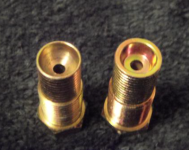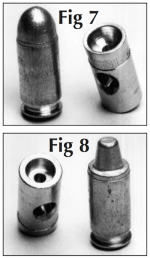You are using an out of date browser. It may not display this or other websites correctly.
You should upgrade or use an alternative browser.
You should upgrade or use an alternative browser.
Ring on bullet
- Thread starter jojo4711
- Start date
ammo.crafter
New member
Seat
Which seater stem are you using? Most dies come with more than one.
Looks like you are using a SWC seating stem rather than a RN stem.
Which seater stem are you using? Most dies come with more than one.
Looks like you are using a SWC seating stem rather than a RN stem.
What cartridge is that? Looks like a 9mm but the max COL for 9mm is 1.169 so if you are loading 1.25 it would be long. Provide more information:
- Cartridge
- Projectile (make and weight)
- Powder type and charge (not really relevant for a COL issue but always good to include)
Where did you get the load data you are using?
- Cartridge
- Projectile (make and weight)
- Powder type and charge (not really relevant for a COL issue but always good to include)
Where did you get the load data you are using?
condor bravo
New member
My guess is that the ring is formed from the bullet seating stem, even though probably a round nose stem, but will not have any drastic effects on casual plinking. The stem probably just doesn't conform to the proper shape or dimension of the bullet nose. That is something that comes up now and again.
polyphemus
New member
That doesn't make much sense,in any case neither the seater die nor the factory crimp die do that to bullets,the powder through die does.I crimp the bullet into the case
I think you need to properly set your dies and as to whether that ring is an issue
all I could say is that if I saw that I would stop and fix the problem.
I have had a ring on the bullet when the seater stem cuts into it.
I took out the seater stem, spun it in a drill, and with some abrasive, rounded over the mouth of the seater stem.
In this pic I am using steel wool, but I have done it with wet and dry sheets and with sandpaper.
The attached photos show what your seating die probably looks like inside. That hole in the die is likely the culprit. You could try polishing it ever so slightly to remove any sharp edges.
The other possibility is that you have the wrong seating stem.


Fly
The other possibility is that you have the wrong seating stem.
Fly
Attachments
Dont sweat it
You bought the cheapest dies possible. There are some drawbacks of buying
Lee dies, other die makers provide multiple seating stems for seating your
different types of bullets. The ring will not affect your reloads but if you dont like the ring, buy reloading dies that provide multiple stems for your seating
die.
You bought the cheapest dies possible. There are some drawbacks of buying
Lee dies, other die makers provide multiple seating stems for seating your
different types of bullets. The ring will not affect your reloads but if you dont like the ring, buy reloading dies that provide multiple stems for your seating
die.
Won't hurt anything. Not much you can do about it if you die only has one seater stem. Round nose FMJ can use a flat stem for a WC bullet and eliminate the ring. You can also use a larger caliber round nose stem. I've swapped seating stems from other calibers to eliminate this in some rounds. Don't know if Lee dies can do that.
Next possible issue lol. I took that same cartridge and chambered/ejected it in my glock 19. The first time it got hung up on the barrel, so I inspected the cartridge and it had some scratches on the case. Then I did it again and it did fine, but still leaving small scratches on the case where it is hitting the feed ramp and sliding into the barrel. Does this mean the die is opening the mouth too much for seating the bullet? Compared to a federal round, it feels like there is a slightly higher "hump" where the bullet meets the case on my round.


Do you have a gauge to check the round?

If not, that is awfully handy for making sure the round will chamber in a gun. It looks like your scrapes are more than just from the feed ramp. If it were just the ramp, the contact area would be very limited, but yours appears to be a good way around the case. Is it just stopping partially chambered with the slide not in battery? If so, a gauge would be handy in knowing that was going to happen before you even got to the range.
Possibly related...it appears from that picture that your crimp is quite tight, possibly rolled. This can cause the case to be too large to chamber.
Fly
If not, that is awfully handy for making sure the round will chamber in a gun. It looks like your scrapes are more than just from the feed ramp. If it were just the ramp, the contact area would be very limited, but yours appears to be a good way around the case. Is it just stopping partially chambered with the slide not in battery? If so, a gauge would be handy in knowing that was going to happen before you even got to the range.
Possibly related...it appears from that picture that your crimp is quite tight, possibly rolled. This can cause the case to be too large to chamber.
Fly
Attachments
Last edited:
I have the RCBS seater plug assortment. When I go to the range it is most unlikely anyone is going to notice an artifact left by the seating plug and it does not bother me.
I am the fan of datums, my datums have sharp edges, I like that in a datum, it is not necessary for my seating plugs to have sharp edges.
F. Guffey
I am the fan of datums, my datums have sharp edges, I like that in a datum, it is not necessary for my seating plugs to have sharp edges.
F. Guffey
I took the barrel out and the cartridge fits in there the exact same as the Federal factory round. So it must just be when the round is being chambered. There are multiple scratches because I loaded the round several times to see if it would make scratches every time. I was planning on getting a gauge, just haven't yet. If there is a bulge, would that be from too big of an opening or from too much crimp on the last die?
I have been shooting/reloading semi-autos for mebbe 16 years and still don't have any need for a case gauge. Use the barrel and look up the "Plunk Test". Every reloader should own a good dial caliper and a good 1" micrometer. Whenever there is a fit problem, measure!  Find out where the cartridge is too big and when it is done. Then you can correct it...
Find out where the cartridge is too big and when it is done. Then you can correct it...
http://thefiringline.com/forums/attachment.php?attachmentid=95622&d=1402071747 scroll down the the pic...
http://thefiringline.com/forums/attachment.php?attachmentid=95622&d=1402071747 scroll down the the pic...
Seater plug. Nothing to worry about. The case is getting scratched because it's being violently tossed around by the pistol. Also nothing to worry about. As long as it feeds.
Been shooting/reloading semi-autos for 40 years and totally agree. Best gauge is the chamber. A digital(easier to read) vernier can be locked and used as case gauge. Have a 0 to 1 micrometer but rarely use it.
Been shooting/reloading semi-autos for 40 years and totally agree. Best gauge is the chamber. A digital(easier to read) vernier can be locked and used as case gauge. Have a 0 to 1 micrometer but rarely use it.





